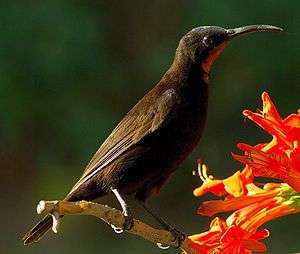Amethyst sunbird
| Amethyst sunbird | |
|---|---|
 | |
| Male of the nominate race, Western Cape | |
| Scientific classification | |
| Kingdom: | Animalia |
| Phylum: | Chordata |
| Class: | Aves |
| Order: | Passeriformes |
| Family: | Nectariniidae |
| Genus: | Chalcomitra |
| Species: | C. amethystina |
| Binomial name | |
| Chalcomitra amethystina (Shaw, 1812) | |
| Synonyms | |
|
Nectarinia amethystina | |
The amethyst sunbird, also called the black sunbird (Chalcomitra amethystina), is a species of passerine bird in the Nectariniidae family. It is native to the Afrotropics, mostly south of the equator.[2] They are commonly found in well-watered habitats, and undertake seasonal movements to visit flowering woodlands. The demise of some woodlands have impacted their numbers locally, but their range has also expanded along with the spread of wooded gardens.
Habits
Though mostly found singly or in pairs, larger numbers may concentrate at favourite flowering trees, where they act aggressively towards other sunbird species.[3] The complex song is a loud, sustained twittering.[3] Food includes emergent termites, spiders and nectar.[4] In courtship a male will hop about a branch near a female, droop one wing, then the other, and finally both wings. The wings will then be fluttered and displayed. A responsive female may lower her head, and assume a rigid posture.[5]
Nesting
Breeding pairs are widely spaced, and the female builds the nest.[6] Favoured trees include exotic eucalypts and pines, and are often close to buildings or human activity.[5] Nests are attached to a drooping branch, below the canopy, or hidden by foliage.[6] Nests are built from fine grass stems, which are bound together with cobweb.[6] The nest is often decorated with lichens,[3] or other debris. Two speckled eggs are laid, but successive clutches may be raised from the same nest, in a single season.[6] Nests are parasitized by Green-backed honeybird and Klaas's cuckoo.[2]
Habitat and movements
They are widespread residents of woodland, mesic savanna, forest edge and suburban gardens.[3] They occur only sparsely in dry savanna[7] or low dry regions, where they keep to riparian woods or concentrations of nectar-bearing plants,[3][7] and are decidedly scarce in the Limpopo valley and mopane regions.[8] A distinct summer influx is notable in the Zambezi valley and Great Zimbabwe woodlands,[7] and they are strictly summer visitors (September/October to April) to the Kalahari sand (or Gusu) woodlands, where they appear in high densities when the Baikiaea trees are in flower.[7] On seaward-facing slopes, they are very common residents up to 1,800 metres,[7] with high reporting rates in afromontane forest and valley bushveld.[8]
Status
On the Mashonaland plateau, race kirkii has declined in favour of Scarlet-chested sunbird, after fragmentation of its native miombo woodlands.[8] In South Africa the range of the nominate race has increased along with the spread of wooded gardens.[2]
Range
It occurs in Angola, Botswana, Burundi, Republic of the Congo, Democratic Republic of the Congo, Ethiopia, Gabon, Kenya, Malawi, Mozambique, Namibia, Somalia, South Africa, South Sudan, Swaziland, Tanzania, Uganda, Zambia and Zimbabwe.
Races
Between three[9] and eleven[10] races have been proposed, including:
- C. a. amethystina – South Africa, southern Botswana, Swaziland
- Fairly distinct: bill heavy, females dark from throat to belly, males have tail coverts metallic purple
- C. a. kirkii Shelley, 1876 – Zimbabwe to East Africa
- Bill finer, females much lighter on underside, males with dark brown tail coverts
- C. a. kalckreuthi (Cabanis, 1878) – coastal Tanzania and Kenya
- Bill slender, females pale below, unmarked on throat, supercilium long, males may have metallic purple upper tail coverts;[3] often merged with C. a. kirkii
- C. a. deminuta Cabanis, 1880 – West African tropics
- C. a. doggetti (Sharpe, 1902) – western Kenya
- C. a. adjuncta (Clancey, 1975) – Swaziland
- Often merged with C. a. amethystina
Gallery
-

Female of the nominate race feeding on Aloe nectar
-

Female specimen, likely C. a. kirkii, Kenya
-

Immature male of the nominate race
-
%2C_nes%2C_a%2C_Seringveld.jpg)
Female in nest suspended from low tree branch
References
- ↑ BirdLife International (2012). "Nectarinia amethystina". IUCN Red List of Threatened Species. Version 2012.1. International Union for Conservation of Nature. Retrieved 16 July 2012.
- 1 2 3 "Chalcomitra amethystina (Amethyst sunbird, Black sunbird)". biodiversityexplorer.org. iziko museums. Retrieved 15 October 2014.
- 1 2 3 4 5 6 Zimmerman, Dale A.; et al. (1996). Birds of Kenya and Northern Tanzania. Halfway House: Russel Friedman Books. p. 642. ISBN 1-875091-04-1.
- ↑ "Amethyst Sunbird (Chalcomitra amethystina)". hbw.com. Handbook of the Birds of the World. Retrieved 15 October 2014.
- 1 2 Cowles, Raymond B. (January 1936). "Observations on the Amethyst Sunbird, Chalcomitra amethystina amethystina (Shaw)". The Auk 53 (1): 28–30. Retrieved 15 October 2014.
- 1 2 3 4 Tarboton, Warwick (2000). Field guide to nests & eggs of Southern African birds. Cape Town: Struik. pp. 235–236. ISBN 1-86872-271-6.
- 1 2 3 4 5 Irwin, Michael P. Stuart (1981). The birds of Zimbabwe. Salisbury, Zimbabwe: Quest Pub. pp. 375–376. ISBN 0-86925-156- 2.
- 1 2 3 Harisson, J.A.; et al. (1997). The atlas of southern African birds (PDF). Johannesburg: BirdLife SA. pp. 518–520. ISBN 0-620-20730-2.
- ↑ "Amethyst Sunbird (Chalcomitra amethystina)". The Internet Bird Collection. IBC. Retrieved 15 October 2014.
- ↑ Chittenden, Hugh; Allan, David; Weiersbye, Ingrid (art) (2012). Roberts geographic variation of southern African birds. Cape Town: John Voelcker Bird Book Fund. ISBN 978-1-920602-00-0.
External links
- (Black Sunbird =) Amethyst Sunbird - Species text in The Atlas of Southern African Birds.
